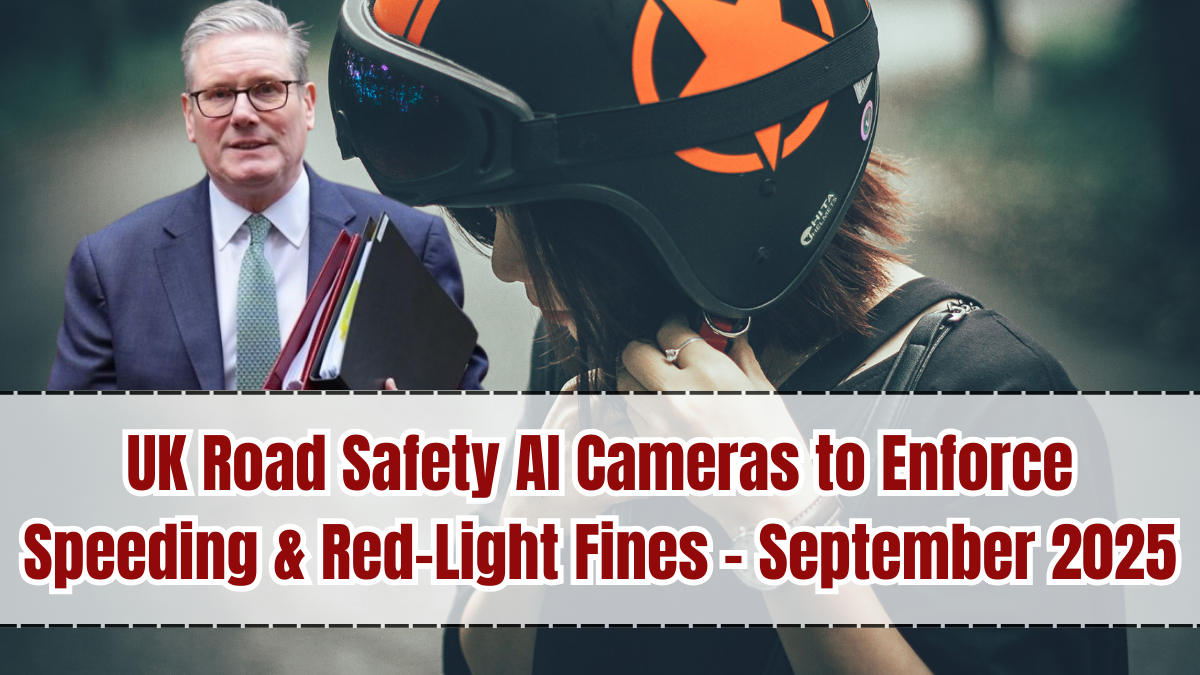The UK government has confirmed the rollout of AI-powered road safety cameras starting in September 2025. This initiative, part of a nationwide traffic enforcement strategy, aims to reduce road accidents by monitoring and penalising speeding and red-light violations more effectively. The UK Road Safety AI Cameras 2025 system combines artificial intelligence with advanced imaging technology to improve accuracy, efficiency, and fairness in traffic law enforcement.
With road safety being a persistent concern, these AI cameras are expected to make UK roads safer while holding reckless drivers accountable.

Why AI Cameras Are Being Introduced
Traditional traffic cameras have been in place for decades, but they are limited in scope and effectiveness. The introduction of AI cameras for speeding fine enforcement addresses several key challenges:
-
Improved Accuracy: AI reduces false positives, ensuring only genuine violations are penalised.
-
Multiple Violation Detection: Cameras can monitor speeding, red-light running, illegal turns, and distracted driving.
-
24/7 Operation: Unlike manual policing, AI cameras function continuously.
-
Faster Processing: Violations are logged and processed in real time, speeding up fine issuance.
-
Consistency: Eliminates human bias in enforcement.
This system is designed to combine fairness with efficiency, ensuring that road safety laws are applied equally.
Key Features of the AI Camera System
The UK Road Safety AI Cameras 2025 project comes with advanced features:
-
Nationwide Rollout: Cameras will be installed across major highways, urban centres, and accident-prone areas.
-
AI-Powered Detection: Capable of identifying multiple types of violations simultaneously.
-
Automatic Fine Processing: Violations are automatically linked to vehicle registration databases.
-
Data Integration: The system works with DVLA records to issue fines directly to offenders.
-
Real-Time Alerts: Local authorities receive instant updates on violations.
-
Privacy Safeguards: AI systems comply with GDPR and data protection regulations.
These features make the AI cameras both powerful and compliant with legal standards.
Implementation Timeline
The rollout will occur in phases starting September 2025:
-
Pilot Program: Testing in high-risk areas to monitor effectiveness.
-
Urban Deployment: Installation in busy city intersections prone to red-light violations.
-
Highway Expansion: Coverage extended to motorways and high-speed routes.
-
Nationwide Integration: Full-scale adoption across the UK by late 2026.
The phased approach allows for gradual improvements and troubleshooting.
How Speeding and Violations Will Be Enforced
The AI camera system will enforce violations through a seamless process:
-
Vehicles exceeding speed limits are detected instantly.
-
Red-light violations are recorded with timestamped images.
-
AI verifies the violation using multiple sensors to reduce errors.
-
Violations are logged into the DWP and DVLA database.
-
Fines are automatically issued to the registered vehicle owner.
This reduces delays and ensures penalties are swift and fair.
Benefits of AI Cameras for Road Safety
The UK Road Safety AI Cameras 2025 are expected to deliver multiple benefits:
-
Accident Reduction: Discourages reckless driving and speeding.
-
Fairer Enforcement: AI eliminates bias and human error.
-
Cost Efficiency: Reduces the need for excessive policing resources.
-
Public Safety: Safer roads protect drivers, passengers, and pedestrians alike.
-
Revenue for Infrastructure: Fines collected will be reinvested in road maintenance and safety programs.
Together, these outcomes strengthen the case for AI-powered enforcement.
Public Concerns and Government Responses
As with any new surveillance technology, there are public concerns:
-
Privacy Issues: Critics worry about mass surveillance. The government has assured compliance with strict data protection rules.
-
Over-Reliance on Fines: Some fear the system will focus more on revenue than safety. Authorities have emphasised that the primary goal is accident prevention.
-
False Positives: While rare, errors may still occur. A transparent appeal system will allow drivers to contest unfair fines.
By addressing these concerns, the government hopes to gain public trust in the system.
Long-Term Impact on Road Safety
The introduction of AI cameras for speeding fine enforcement is expected to transform road safety in the UK:
-
Fewer Accidents: Studies predict a drop in traffic accidents in high-risk areas.
-
Behavior Change: Drivers are more likely to comply with traffic laws knowing AI cameras are always active.
-
Technology Integration: Opens the door for smart road systems and future autonomous vehicle regulations.
-
Global Leadership: Puts the UK at the forefront of AI use in public safety.
The long-term goal is a sustainable, technology-driven road safety framework.
Conclusion
The UK Road Safety AI Cameras 2025 rollout in September 2025 is a bold step toward safer roads and stricter traffic law enforcement. By leveraging AI to detect speeding, red-light running, and other violations, the government is ensuring more accurate and fair enforcement while reducing accidents. Despite concerns about privacy and over-enforcement, the system’s benefits in improving safety and saving lives are expected to outweigh the drawbacks.
FAQs
When will the AI cameras be launched?
The rollout begins in September 2025, starting with pilot areas.
What violations will the cameras detect?
They will monitor speeding, red-light running, illegal turns, and distracted driving.
How will fines be issued?
Violations will be processed automatically, with fines sent directly to registered vehicle owners.
Are there privacy concerns with AI cameras?
Yes, but the system complies with GDPR and data protection laws.
Will the cameras cover the entire UK immediately?
No, rollout begins in September 2025 and will expand nationwide by 2026.
Click here to know more.




